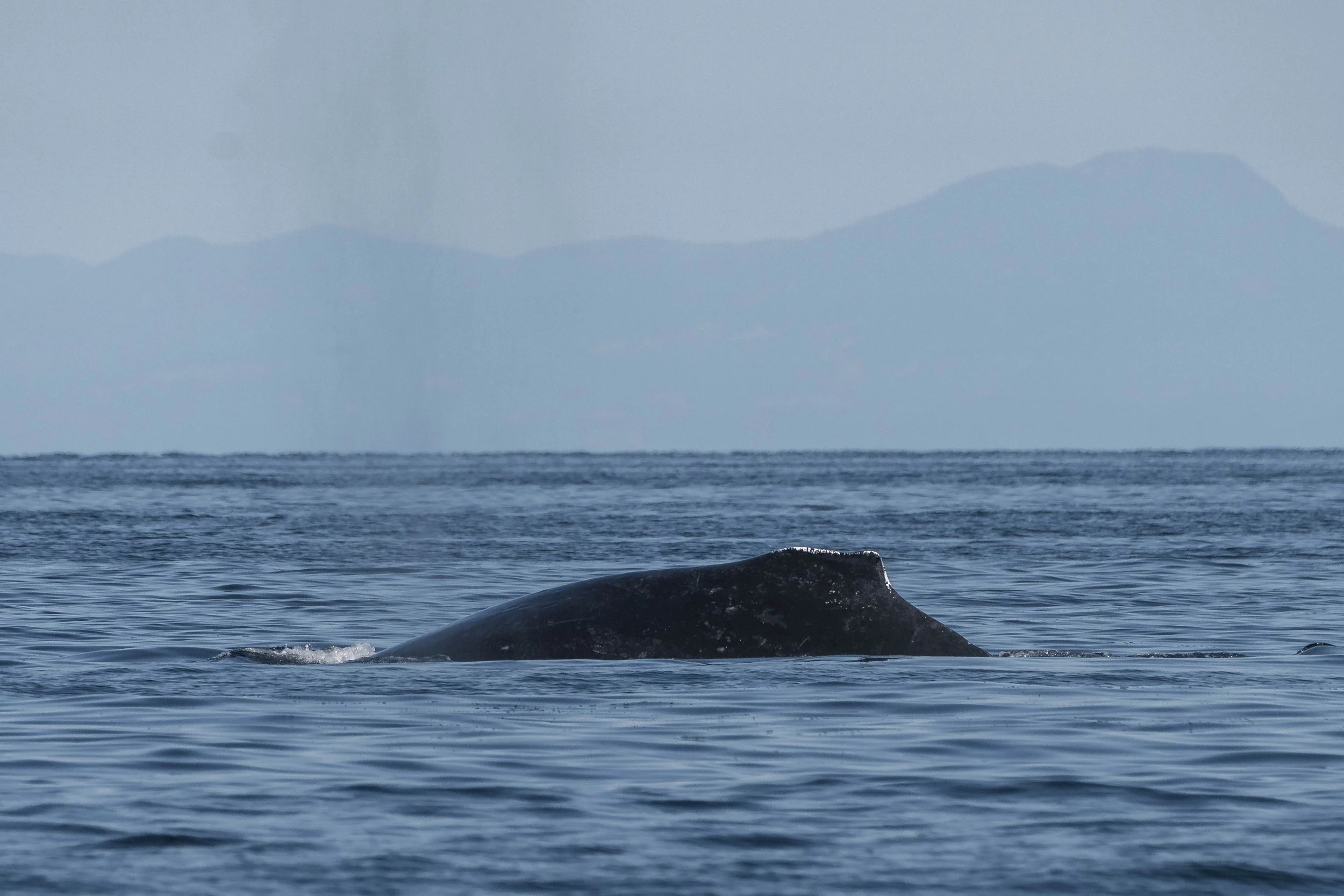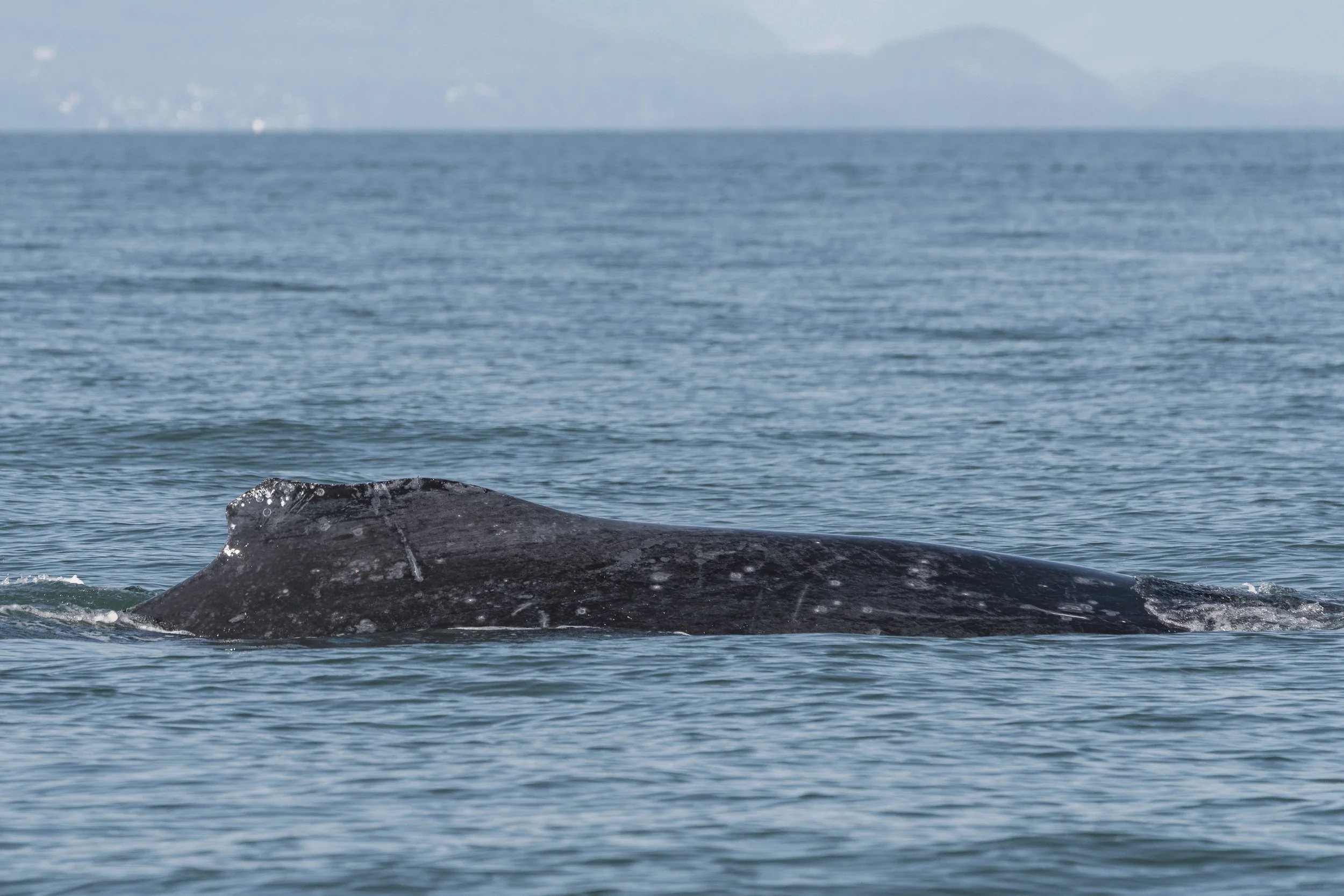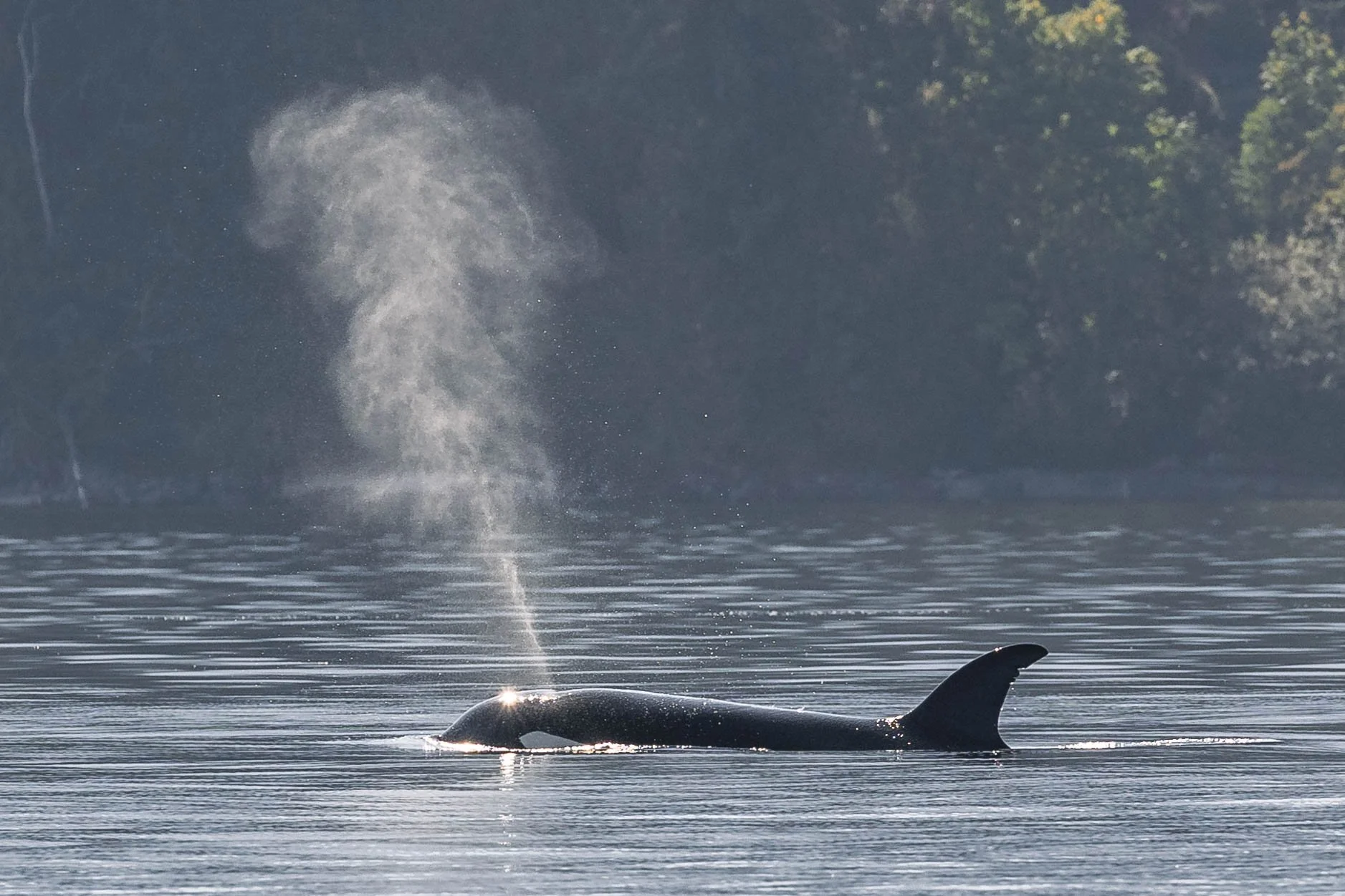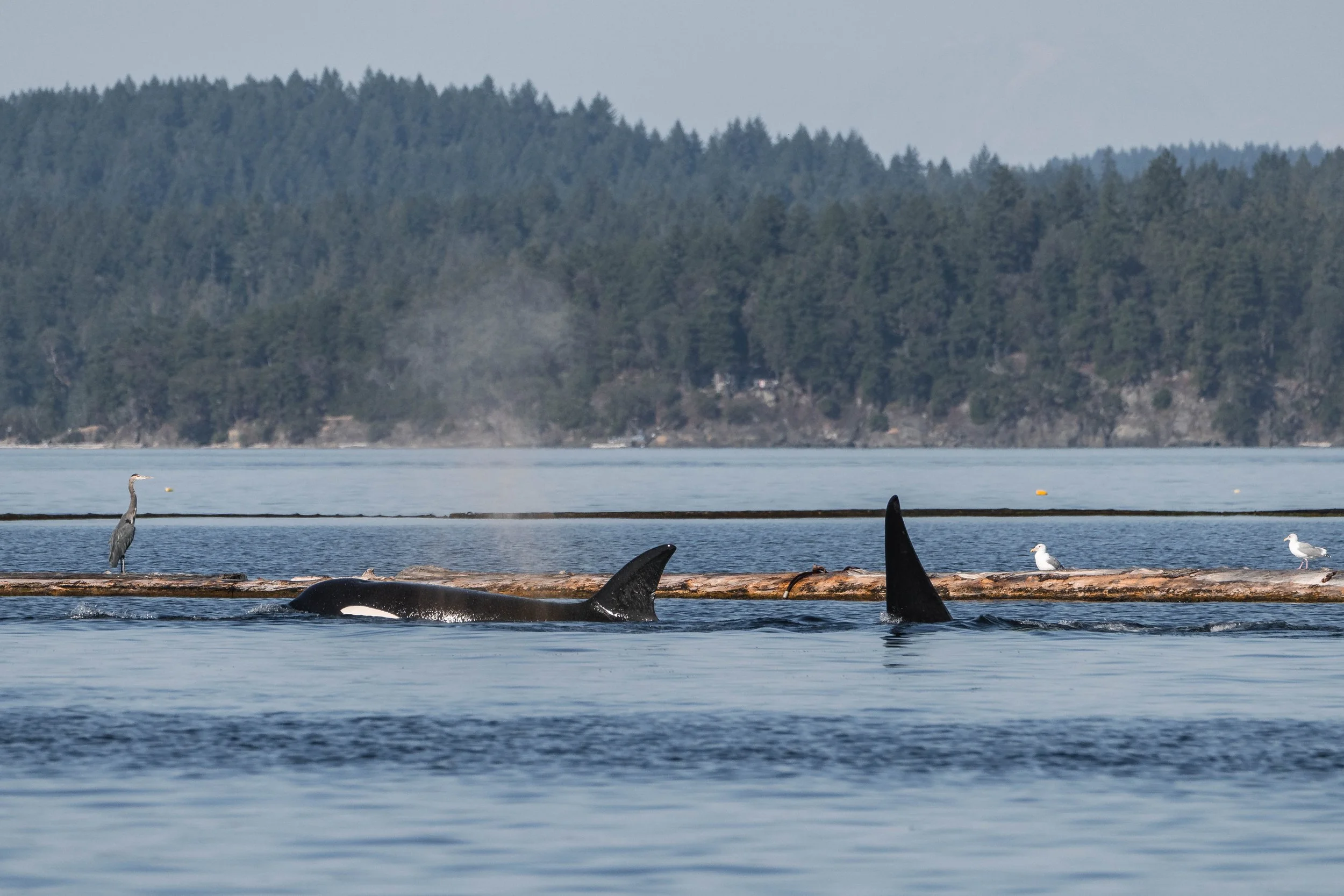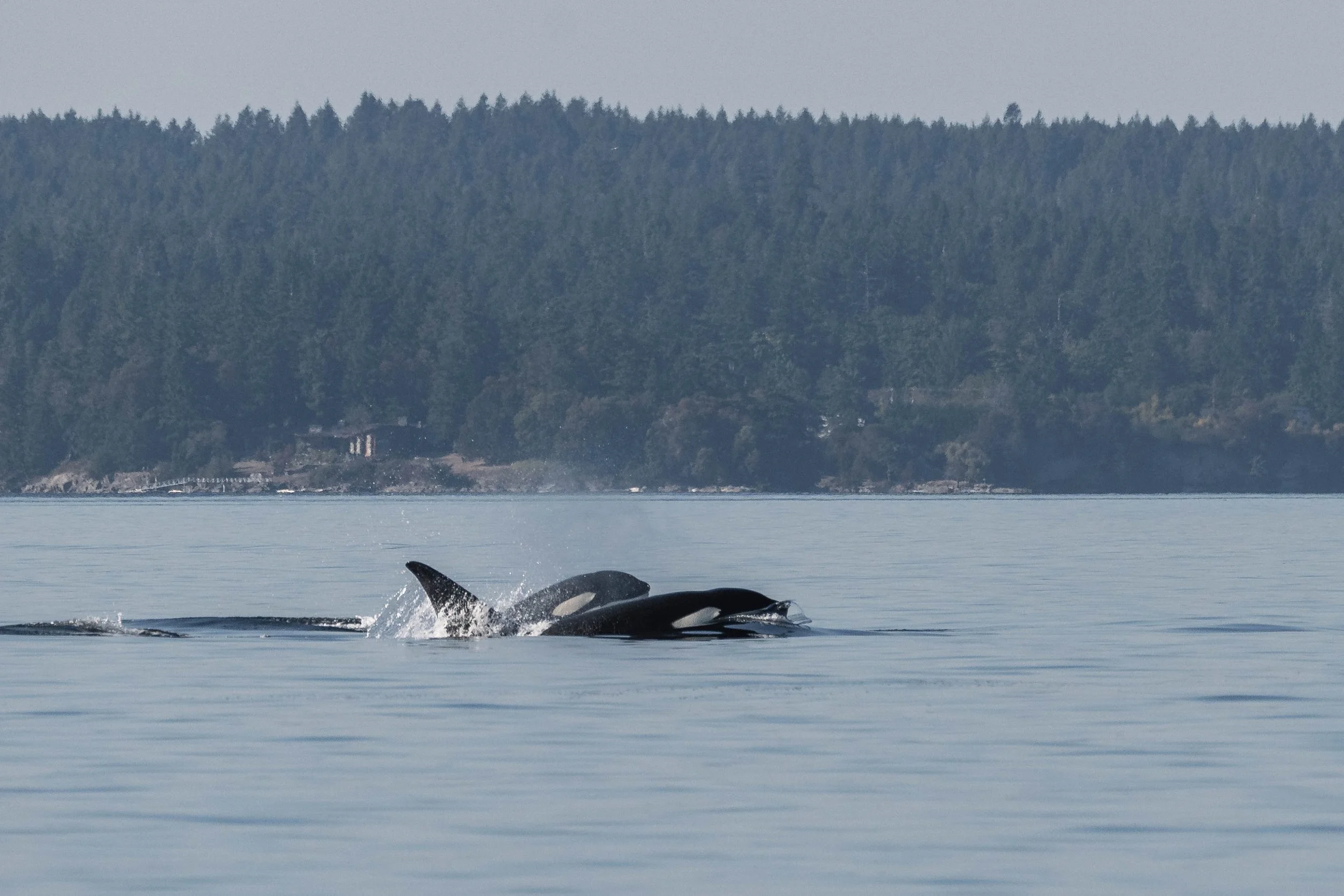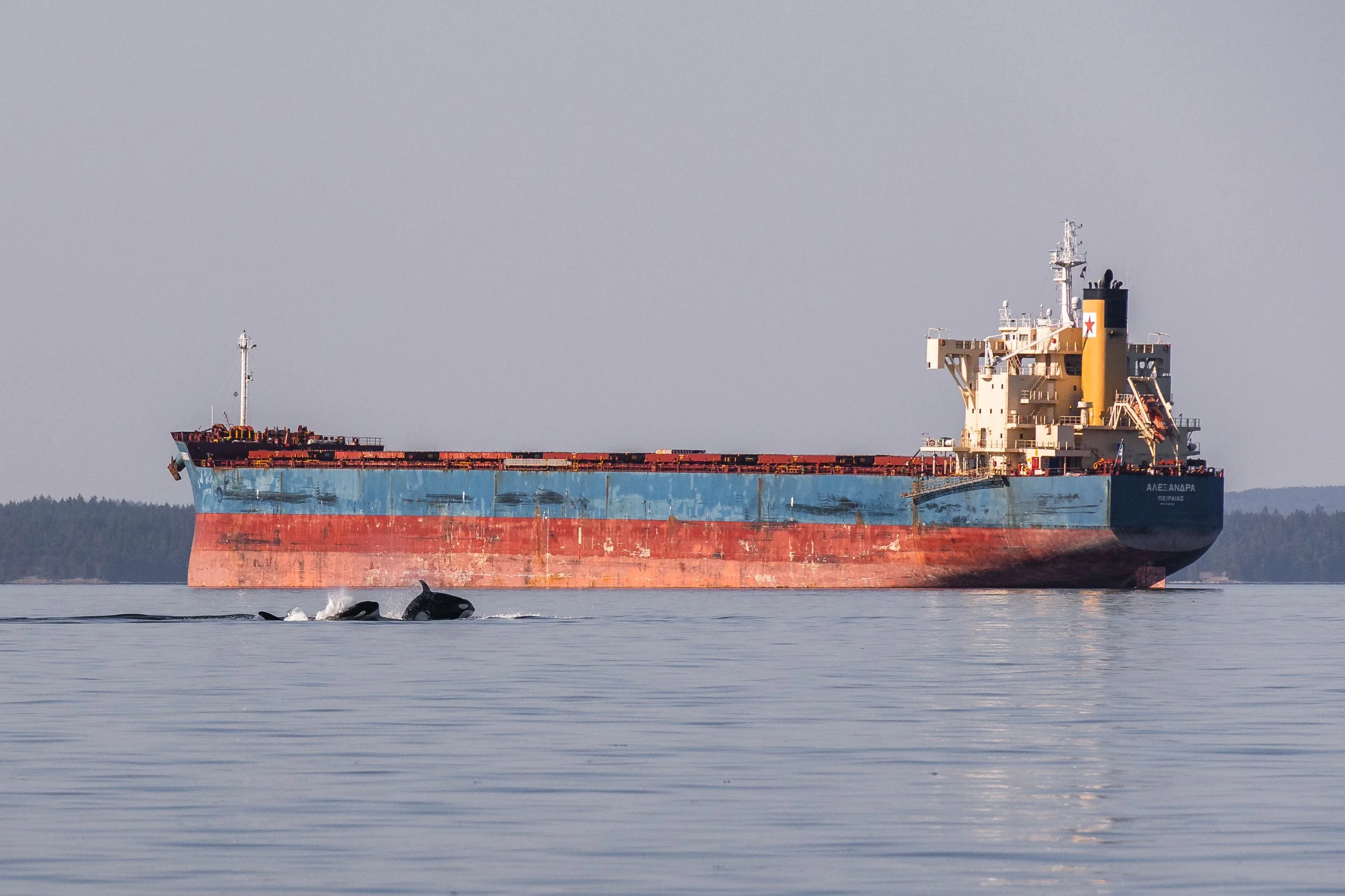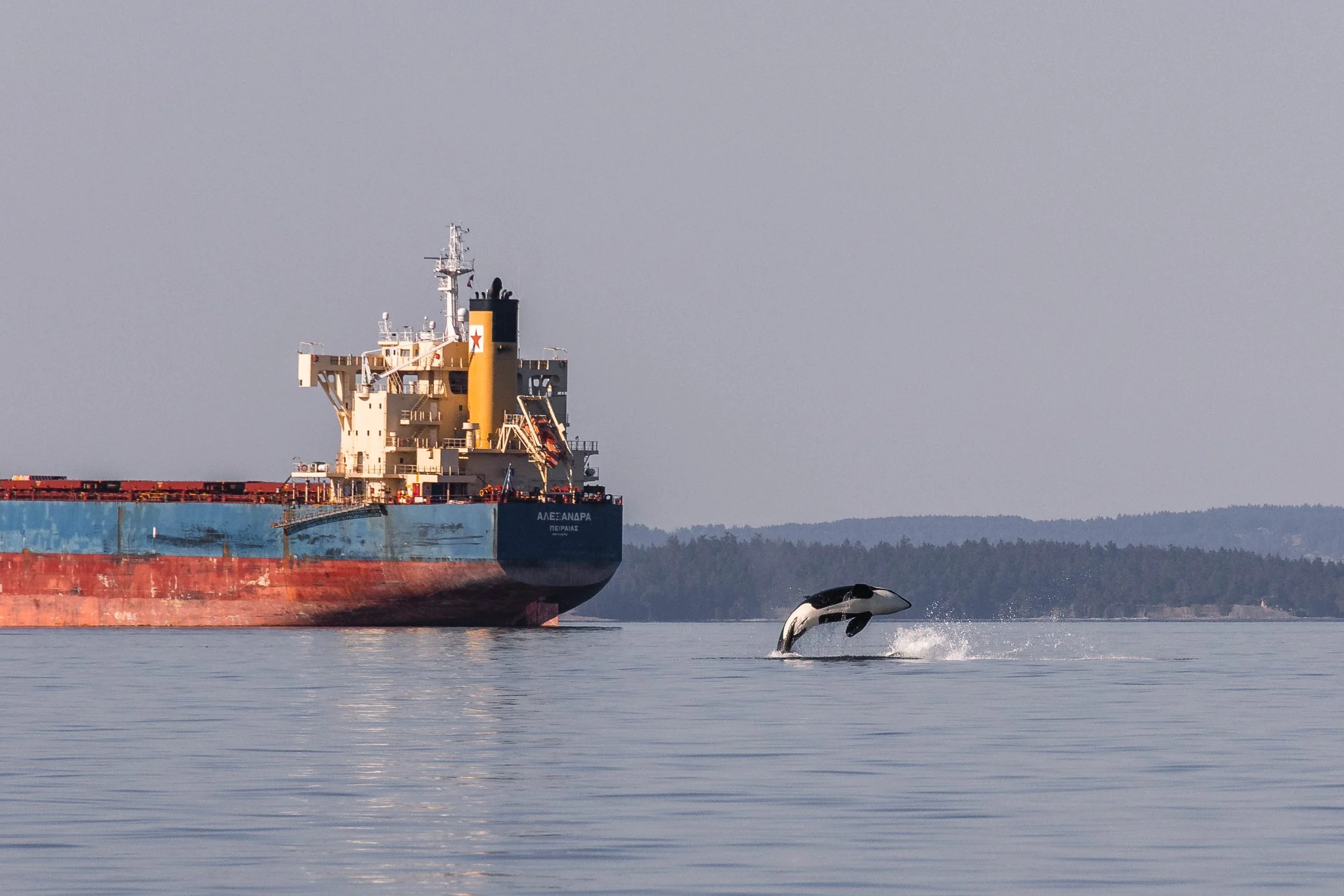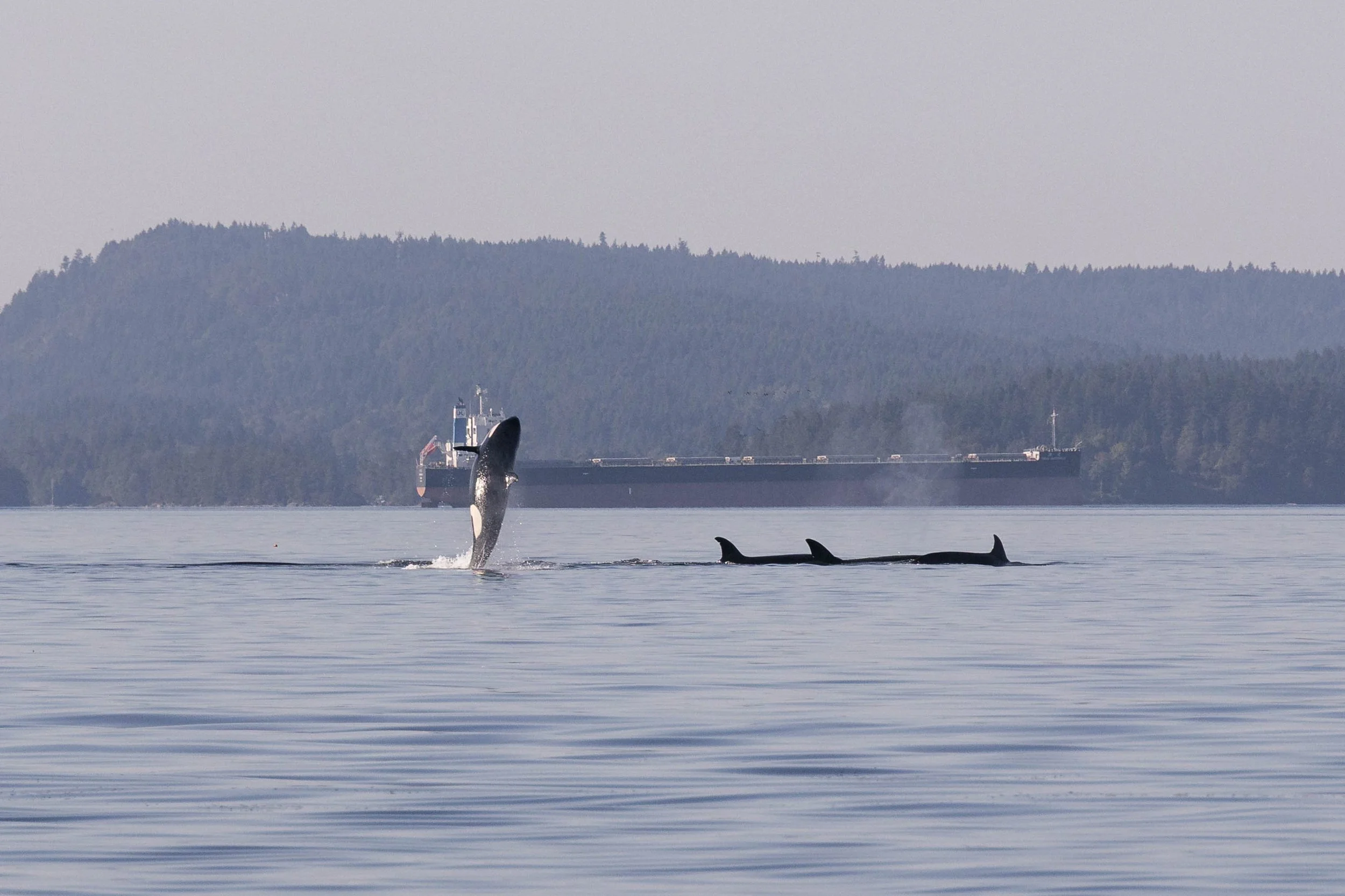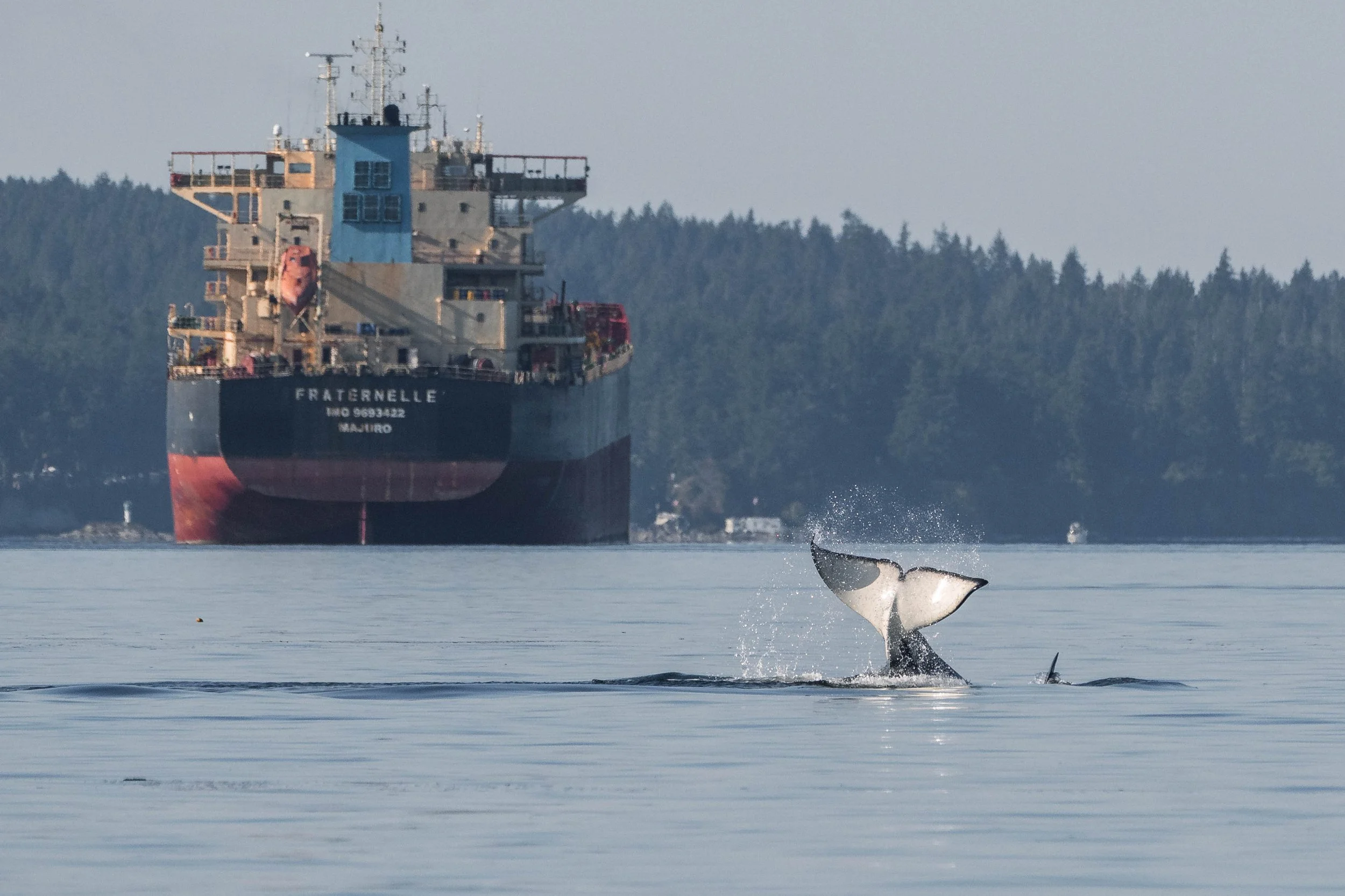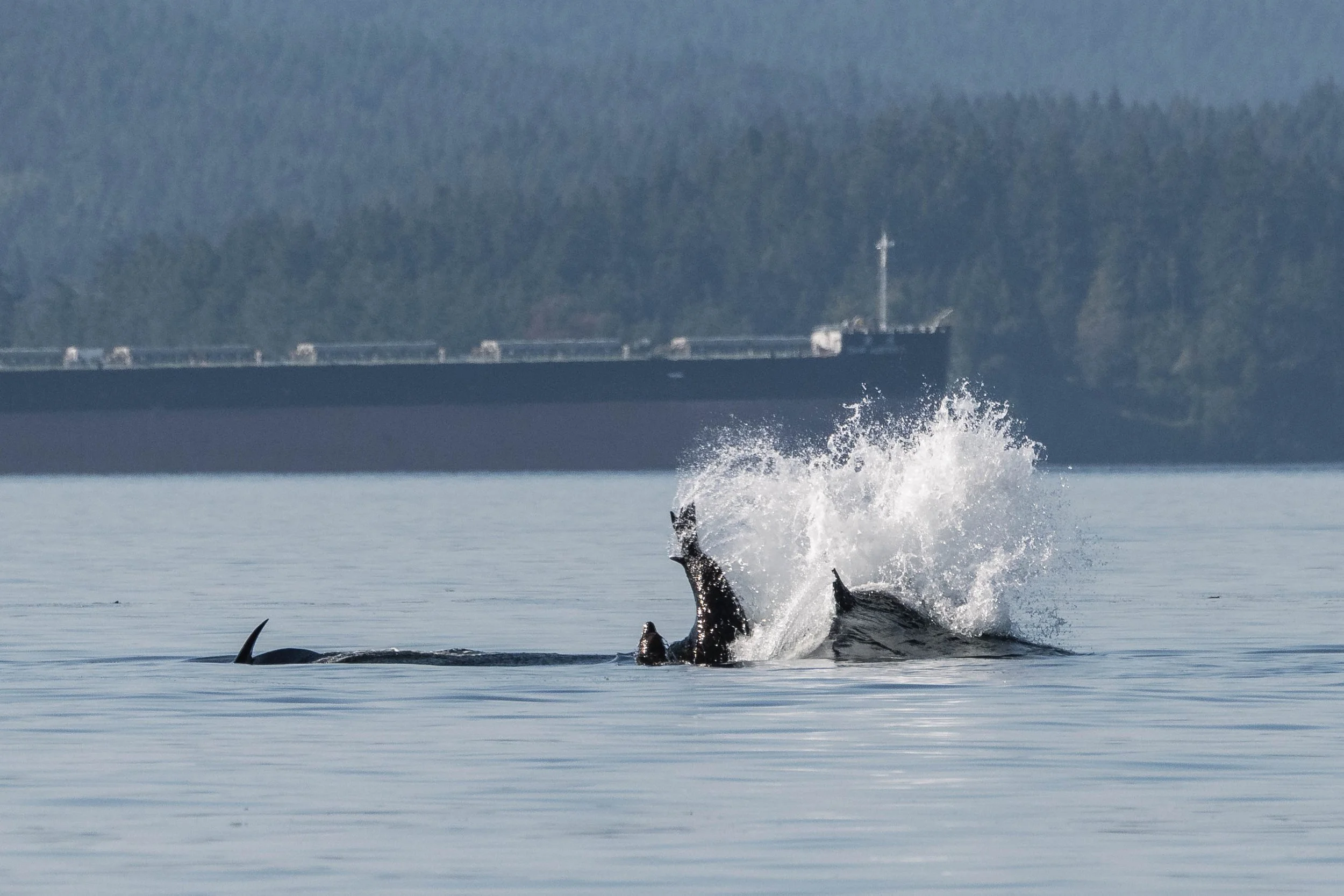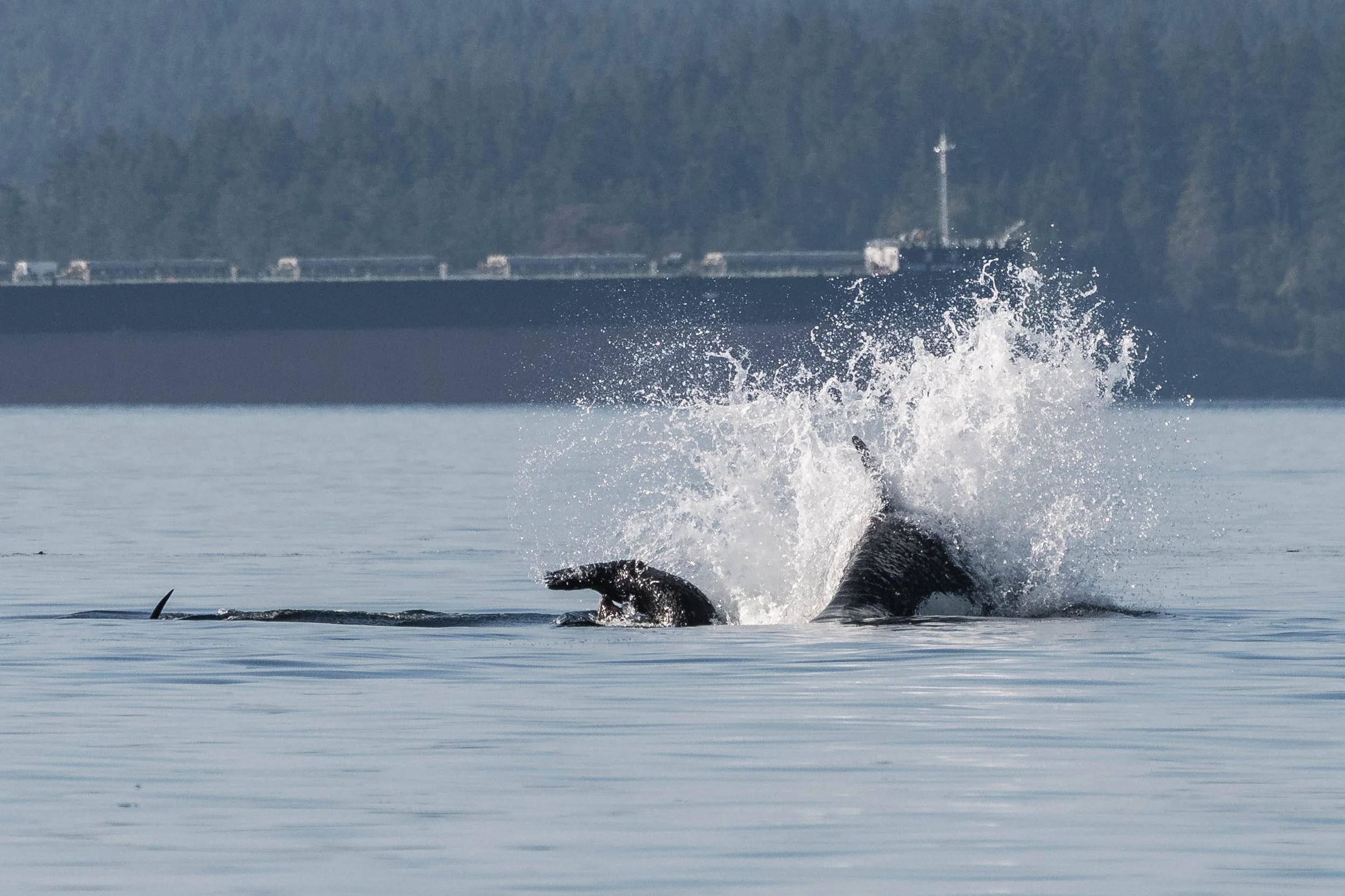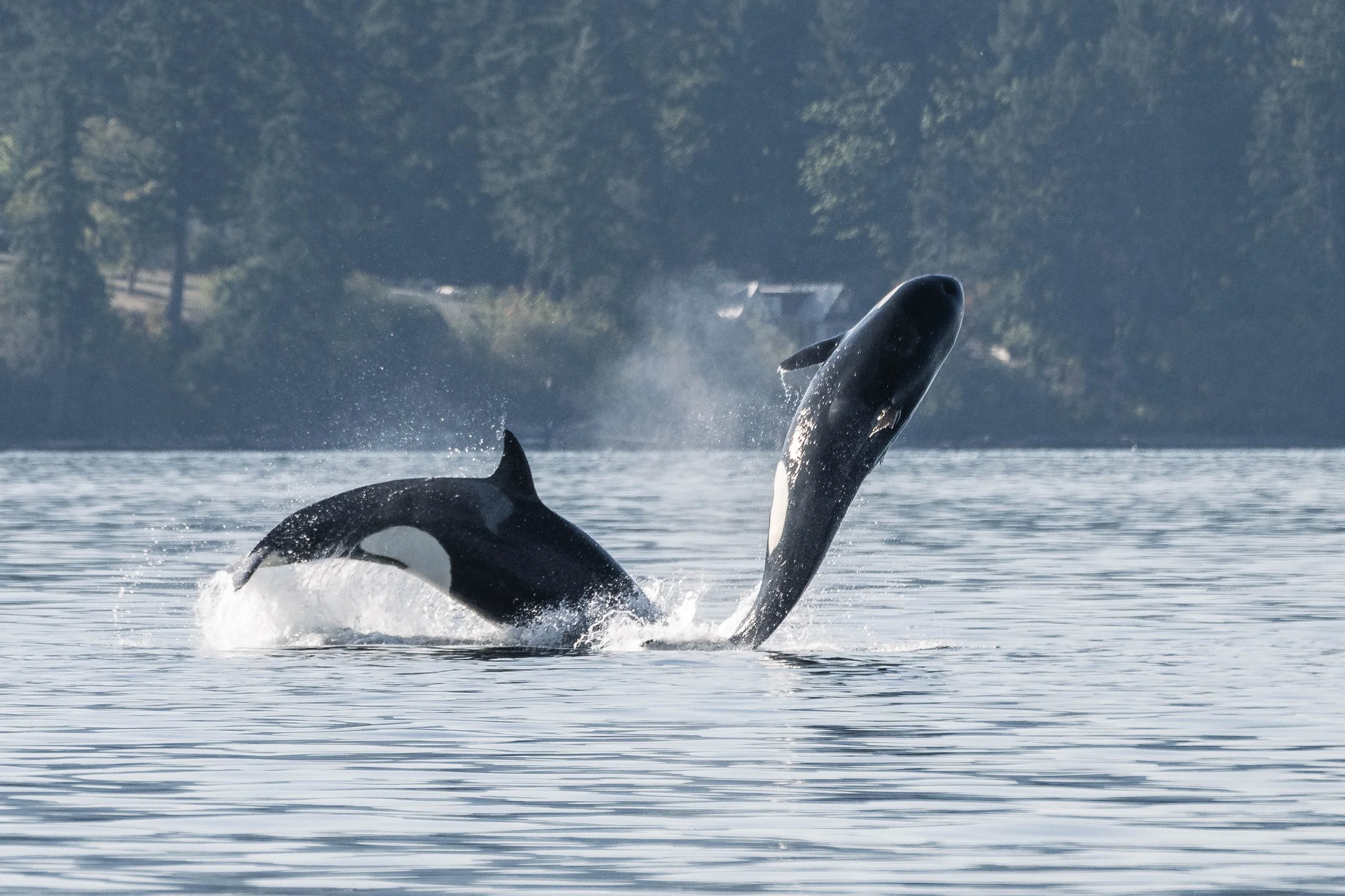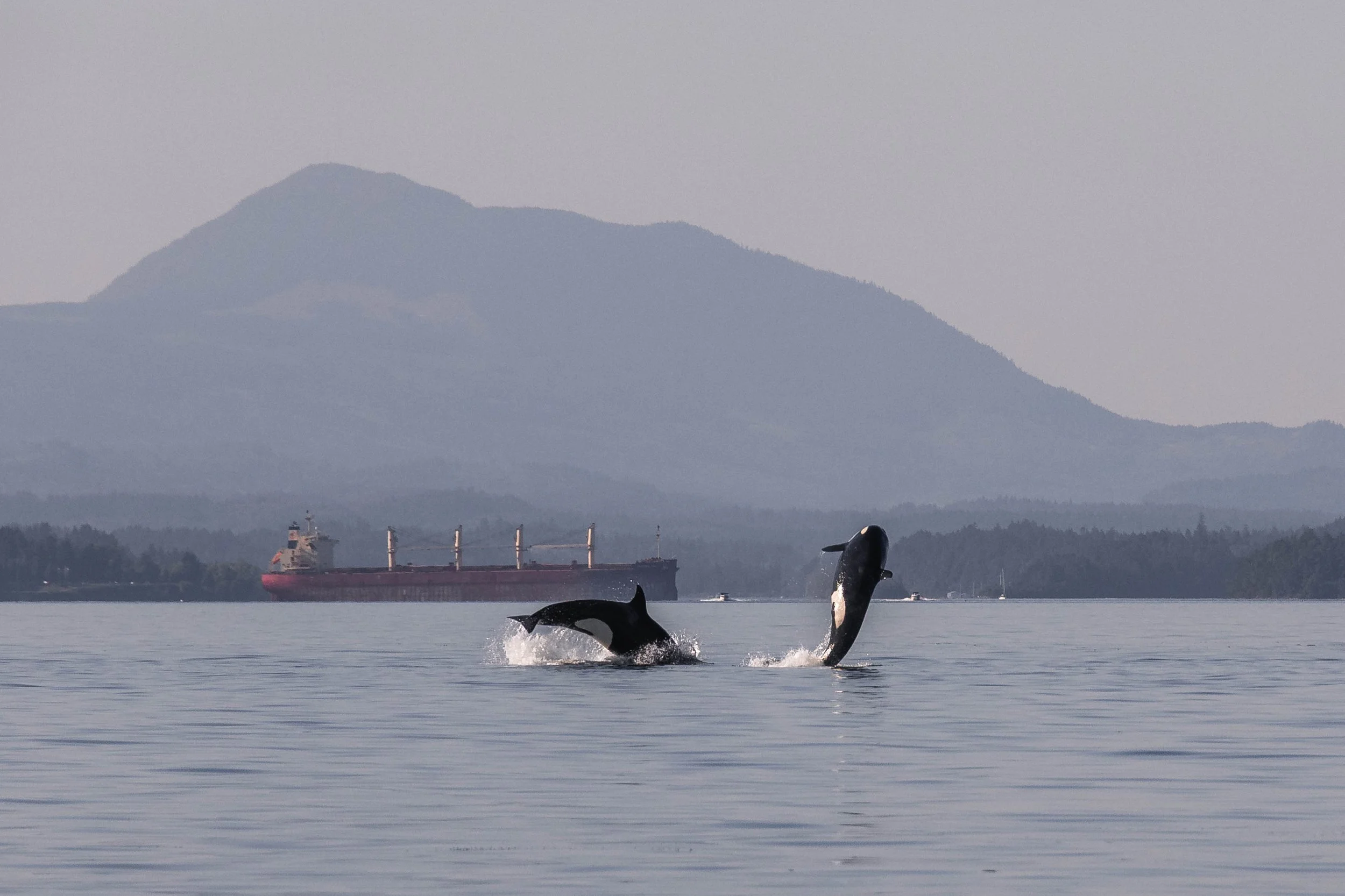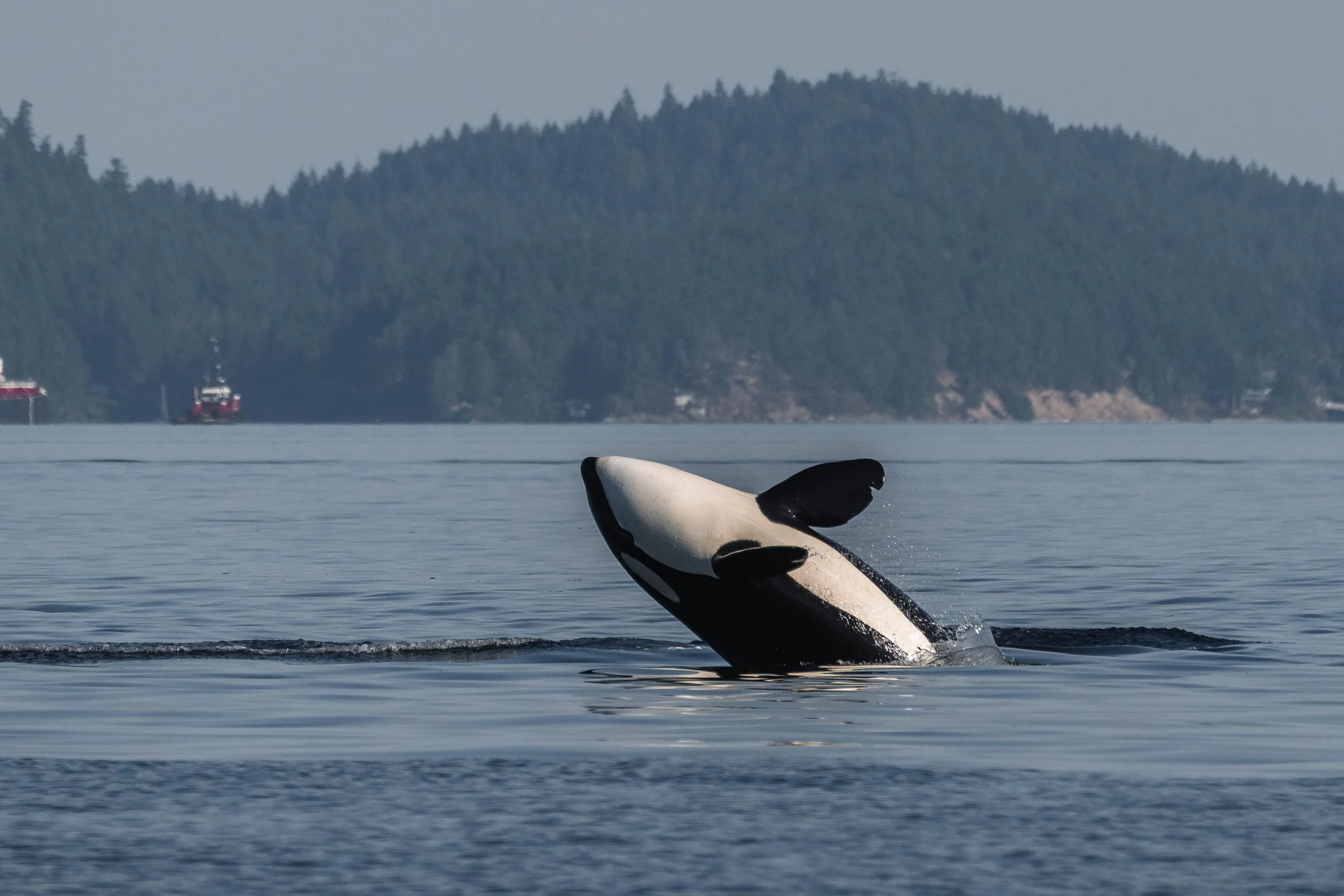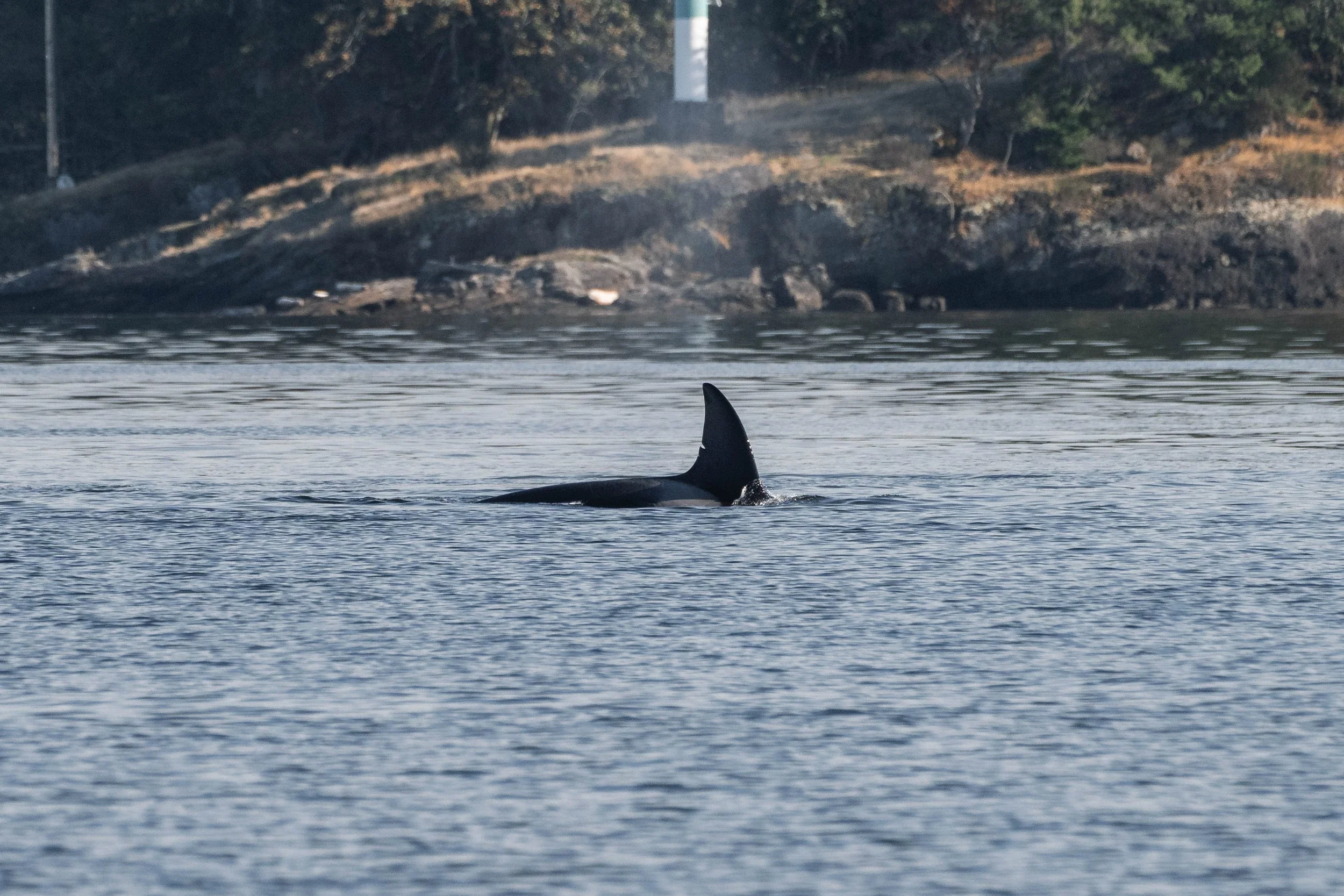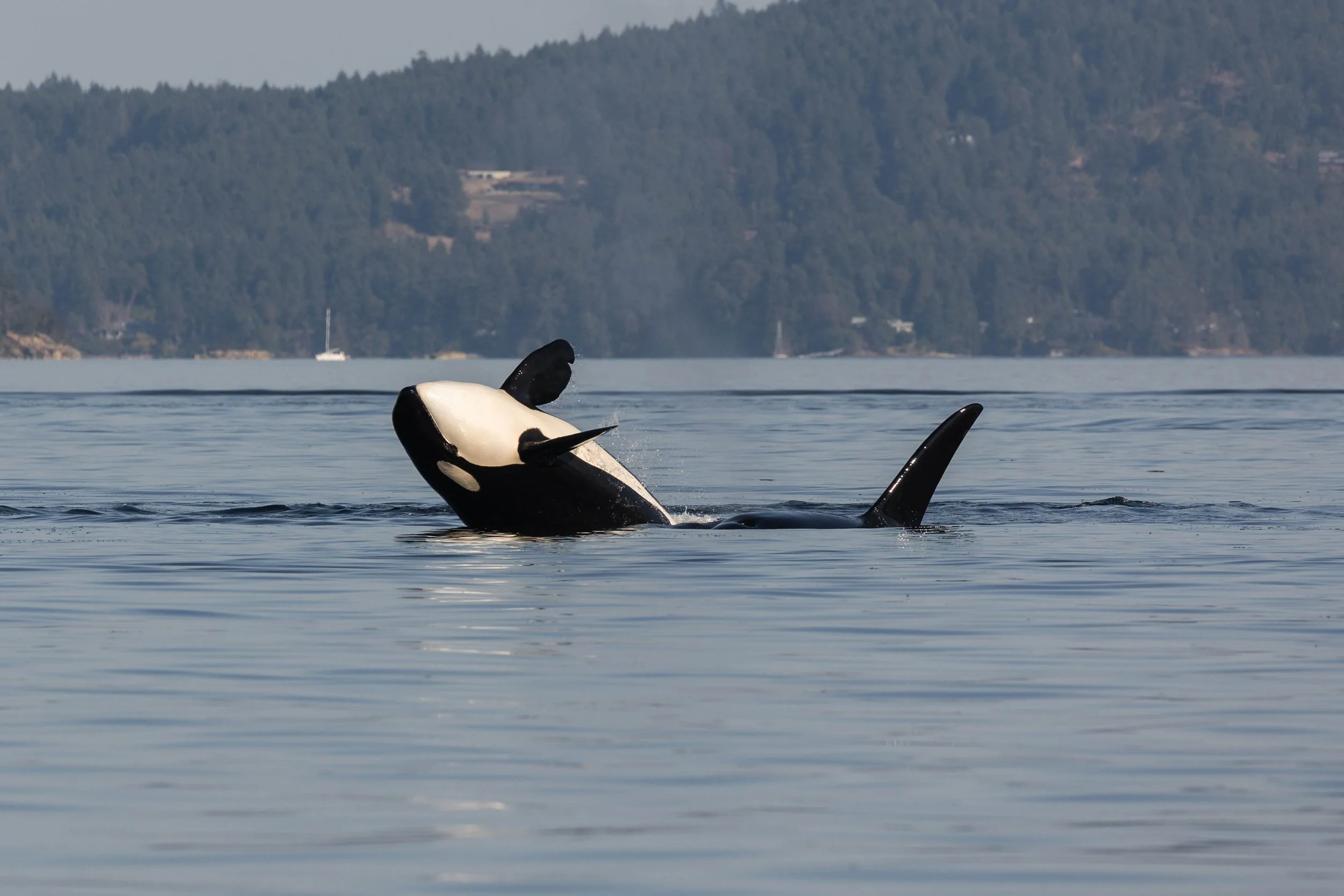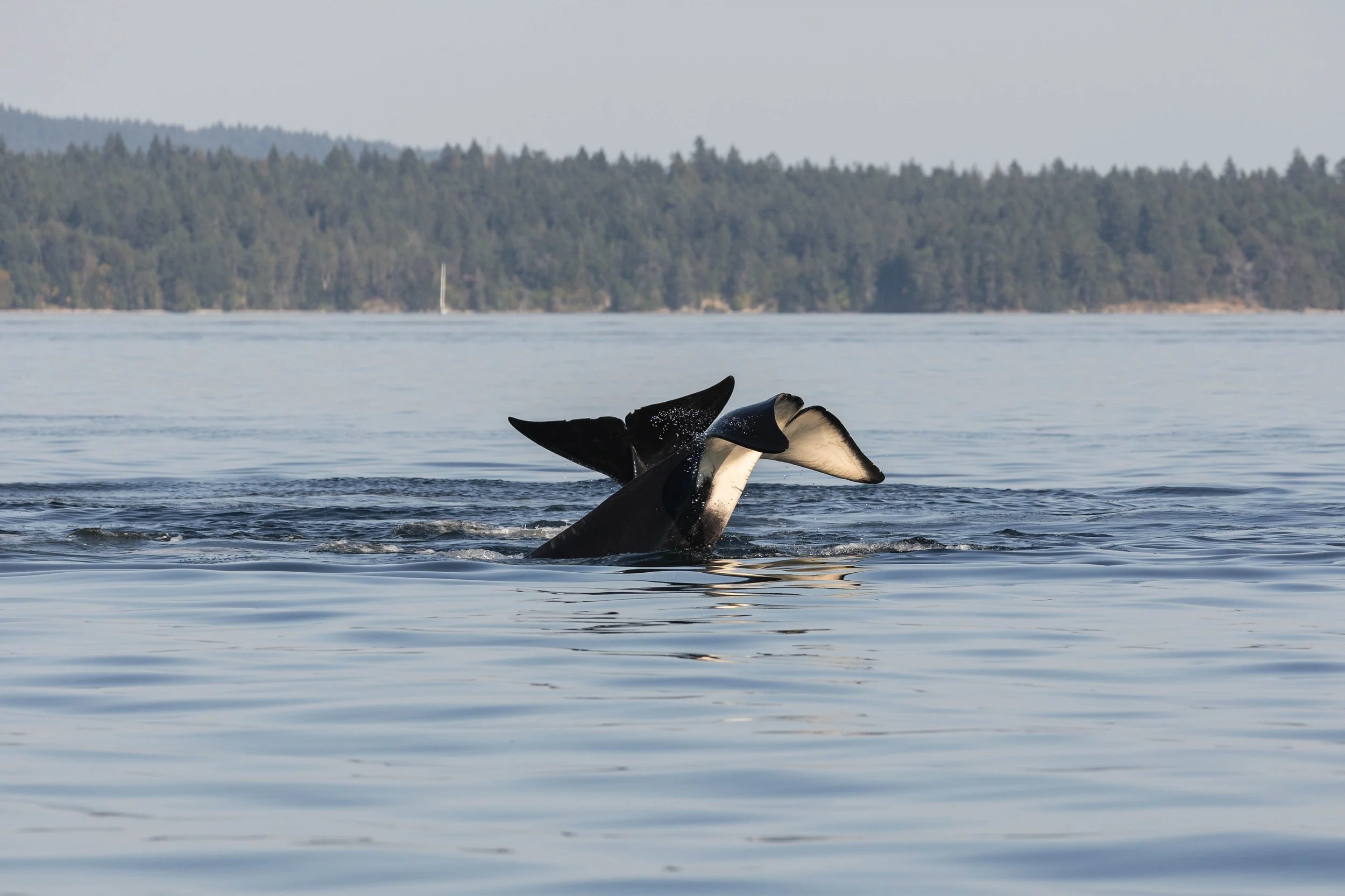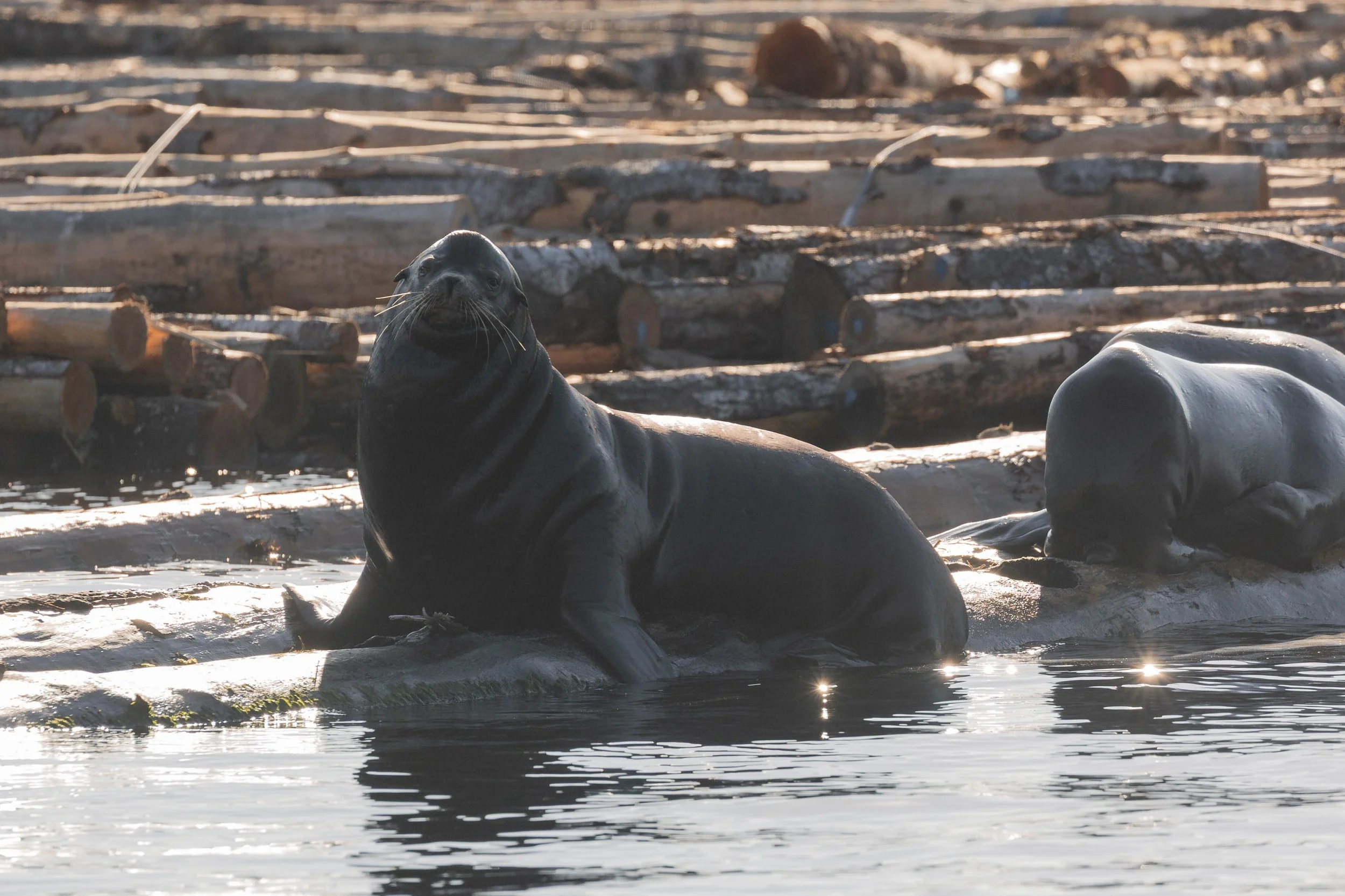September 16, 2025 - T-party off of Chemanius (and some humpbacks in the Strait too)!
It was a gorgeous mid-September afternoon as we set off, eyeing the waters for whales. With the full fleet out and about, we spread out, covering a large area of water as we began looking around. We didn’t have to venture far, though, as a pair of blows and flukes were spotted off Gabriola Island, just outside our harbour. This pair was travelling close together, surfacing and diving synchronously as we watched. As they dove, our onboard Naturalists began snapping photos to identify the individuals with. These two were confirmed as Frankenstein (BCX1358) and Yogi (BCY0409). We watched these two regularly dive and float along, potentially having short naps with ‘snack breaks’ in between. After staying with the pair for a bit, our vessels bid them farewell and headed onward.
After departing from Frankenstein and Yogi, our vessels split up once again and began searching for more wildlife. Open vessel Keta found another humpback shortly after departing, who was busily diving deep into the depths as they observed them. Instead of using this whale’s fluke to identify them, as we do with most whales, the onboard Naturalist confirmed their ID with their dorsal fin. This whale was Trooper (BCX1854). Trooper has a very unique dorsal fin, with a sombre story. Back in 2018, before they were nicknamed, this whale was travelling along in Howe Sound, foraging and building up their fat stores in preparation for the upcoming breeding season. Howe Sound is a beautiful area, bustling with bioactivity, but it is also a favourite spot for boaters. Sometime between April 25th and May 13th, Trooper was struck by a boat, resulting in a large gash just behind their dorsal fin. Luckily, they were able to recover, but a visible notch remains on their back, and a large scar is visible. After surviving this perilous ordeal, the whale was nicknamed Trooper, as a nod to their will to overcome their injuries and to survive.
While Keta stayed with Trooper, Keta and Kula continued onward. They made their way over to another humpback sighting off of Valdez Island. Here, this young whale was travelling and feeding away. Similar to Trooper, this whale’s ID could also be confirmed by their dorsal fin. This whale was Forge (BCZ0410 calf 2022), the 2022 calf of Anvil (BCZ0410). Forge’s dorsal fin is uniquely flat on top, unlike the typical pointed hook shape we see with most of our humpbacks.
Keta departed Trooper and was making their way towards Forge when they stumbled on even more humpbacks of their own! This time, there were three humpbacks travelling very close together. After comparing fluke and dorsal photos, these three were identified as Windy (BCY0893), Dalmatian (BCY0994), and Kelpie (BCY1276). Interestingly, this was a rare encounter in which all the whales present had confirmed genders. Windy and Kelpie have both been confirmed males by biopsy, and Dalmatian has been confirmed male by photography. While humpbacks show little sexual dimorphism (physically, males and females look identical), there is one small characteristic on their bodies that is different. A little, grapefruit-sized bump can be found on the penduncle known as the Hemispherical Lobe. Scientists are still mystified by what this lobe does, but previous photos with Dalmatian on their back tail slapping confirmed a lack of the hemispherical lobe being present, meaning they were a male! While they were observed, these three were surfacing rapidly and travelling quickly, occasionally tail-flicking as they went.
After our pocket full of humpback encounters, we started venturing into the Southern Gulf Islands. We had gotten word that there was an interesting encounter occurring off of Vancouver Island’s coast, and we were eager to go check it out ourselves. As we approached, beautifully backlit blows were cast into the air as several orca surfaced simultaneously. The Naturalists excitedly started snapping photos, this time relying mostly on dorsal fin photos and saddle patch photos, and confirmed these whales as the T036A1s and T099s:
T036A1 Tierna ♀ (2005)
T036A1A Drift ♂ (2022)
T099 Bella ♀ (1984)
T099B Holly ♀ (2007)
T099C Barakat ♂ (2009)
T099D Puck ♀ (2015)
T099E Qwiin qwiin oo qwii la ♀ (2021)
These seven orca were travelling along outside of Chemanius when we first encountered them. They were travelling close to shore, and were likely poking around looking for dinner. As we observed them, they continued travelling south, and made their way into Chemanius Bay. It is always interesting to see wild animals willingly going into areas that are busy and bustling with human activity. It is known that fish-eating ecotypes of orca, such as the critically endangered Southern Resident orca, are known to slow down or even stop hunting if areas are too busy/loud. The Transient orca, on the other hand, have seemed to adapt and are thriving in the busy waters. The man-made sounds can be used to their advantage to cover up their own sounds as they approach prey, deceiving them into a false sense of security. The whales were spotted popping up around a set of log booms, where a small Harbour Seal was hauled out. They circled for a few minutes before breaking away, likely deciding it was too much effort to try to push the small seal in. They changed course and started heading north when suddenly, their behaviour dramatically changed.
They began porpoising (shallowly jumping out of the water), rapidly picking up speed, a far cry from the slow travel they were doing minutes before. Our cameras were clicking away as we began to capture the unfolding action in front of us. The T099s and T036A1s were hunting. Their hunt was so efficient that while on scene, we were not entirely sure what they were hunting. After reviewing photos, it became clear that these orca had caught a sea lion. After a quick stop to divide up the catch, the members of the pods began celebrating. They began porpoising, breaching, tail-slapping, and pectoral fin-slapping at the surface, very excited to have full bellies. Hunts such as this one are vital for young orca to learn the best (and safest) ways to take down prey, especially for females who may one day leave their mother’s side to have a matriline of their own.
We soon had to leave the T036A1s and T099s behind and start heading back to harbour, as the sun was now starting to set. We cruised northbound, up through Dodd Narrows, and back into the Nanaimo Harbour, wrapping up a perfect day out at sea, exploring and getting to witness the rugged beauty of wildlife along the West Coast!
Please enjoy these spectacular shots below taken by Marine Naturalists Val Watson, Cheyenne Brewster, and Hayleigh Hilbert!
Frankenstein’s dorsal fin. Photo by Val Watson.
Frankenstein diving with Yogi beside him. Photo by Val Watson.
Yogi fluking. Photo by Hayleigh Hilbert.
Frankenstein fluking. Photo by Hayleigh Hilbert.
Forge’s dorsal fin. Photo by Val Watson.
Trooper’s dorsal fin. Photo by Cheyenne Brewster.
Dalmatian’s fluke. Photo by Cheyenne Brewster.
Windy’s fluke. Photo by Cheyenne Brewster.
Kelpie’s fluke. Photo by Cheyenne Brewster.
Kula watching T036A1A Drift, T099B Holly, and T099E Qwiin qwiin oo qwii la. Photo by Cheyenne Brewster.
T099C Barakat. Photo by Hayleigh Hilbert.
A beautiful backlit blow from T036A1A Drift. Photo by Hayleigh Hilbert.
T099C Barakat with a beautifully backlit blow. Photo by Hayleigh Hilbert.
T099B Holly with a backlit blow. Photo by Hayleigh Hilbert.
T036A1 Tierna and T099B Holly with a little Harbour Seal in front of them. Photo by Cheyenne Brewster.
T036A1 Tierna with T099C Barakat behind her, and a Great Blue Heron and two Gulls along the log booms. Photo by Val Watson.
T099C Barakat exploring the log booms. Photo by Val Watson.
T036A1A Drift with his scarred up back visible. Photo by Hayleigh Hilbert.
T099 Bella. Photo by Hayleigh Hilbert.
T099B Holly. Photo by Hayleigh Hilbert.
A Great Blue Heron with T099B Holly lurking behind it. Photo by Val Watson.
Racing towards the hunt. Photo by Val Watson.
T099E Qwiin qwiin oo qwii la, T036A1 Tierna, T099B Holly, and T099C Barakat. Photo by Val Watson.
Eagerly approaching the catch. Photo by Cheyenne Brewster.
Breaching and celebrating. Photo by Cheyenne Brewster.
Breach for the sky! Photo by Cheyenne Brewster.
T099C Barakat tail slapping. Photo by Cheyenne Brewster.
Slapping away. Photo by Val Watson.
Actively hunting the sea lion. Photo by Val Watson.
Ramming is a common tactic for hunting orca. Photo by Val Watson.
T099E Qwiin qwiin oo qwii la and T036A1A Drift celebrating the meal. Photo by Val Watson.
Celebrating the meal: The same breach/porpoise from three different angles
Breaching and porpoising! Photo by Val Watson.
From a side perspective. Photo by Hayleigh Hilbert.
The same moment, from a wider angle! Photo by Cheyenne Brewster.
T099E Qwiin qwiin oo qwii la witth another one breaching beside her. Photo by Val Watson.
Backlit blows, surfacing in a row. Photo by Val Watson.
Tail slapping away. Photo by Val Watson.
T099D Puck with his large pectoral fin chunk missing. Photo by Val Watson.
T036A1 Tierna. Photo by Val Watson.
Back diving. Photo by Hayleigh Hilbert.
Coming in for a landing! T099D Puck and T099C Barakat. Photo by Hayleigh Hilbert.
T099D Puck and T099C Barakat. Photo by Hayleigh Hilbert.
T099B Holly is looking very chunky right now! Photo by Hayleigh Hilbert.
A beautiful fluke! Photo by Hayleigh Hilbert.
Pec fin slapping away! Photo by Hayleigh Hilbert.
T099D Puck with his pectoral fin chunk visible. Photo by Hayleigh Hilbert.
Tails up! Photo by Hayleigh Hilbert.
T099C Barakat tail slapping and T036A1 Tierna. Photo by Hayleigh Hilbert.
T099B Holly catching some air. Photo by Cheyenne Brewster.
A weary Harbour Seal sneakily swims by. Photo by Hayleigh Hilbert.
A Great Blue Heron taking off. Photo by Val Watson.
A California Sea Lion curiously watching us. Photo by Hayleigh Hilbert.
Scratching an itch. Photo by Hayleigh Hilbert.
Snoozing away on the logs. Photo by Hayleigh Hilbert.

